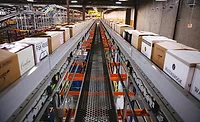Recipes for Integration

Despite last year’s economic recession, companies spent a record $4.8 billion on enterprise integration software and services, up sharply from the previous year’s $3.9 billion, according to a recent study by automation consultants ARC Advisory Group. On the strength of 20 percent projected annual growth, that figure will more than double to $11 billion within four years. A sizable chunk will go toward shop-floor systems integration, a necessary precursor to the business-to-business links sought by sales and marketing executives.
General recipe management is in the crosshairs of many current integration initiatives as processing firms try to eliminate the need for control systems engineering in the deployment of product recipes from the R&D lab to the plant floor. Software programs that manage general recipes are critical if faster time-to-market is to be achieved, and these programs must interface with master recipe systems that translate general recipes into equipment-specific processing instructions.The open architecture roadmap for making this seamless information transfer exists in the ANSI/ISA S-88 batch control standard, which defines the general recipe model. “People typically define recipes according to a specific product and a production line,” observes Jim Brown, marketing vice president for Sequencia Corp., Media, Pa. “That’s fine if you only have one plant, but it works against producing the same product at multiple locations, whether they’re your own plants, a copacker’s facility or sites acquired through a recent merger.” Detailed, understandable general recipes have allowed companies involved in the semiconductor sector to outsource all their manufacturing while maintaining product consistency. That business model now is coming to food and beverage.
Two years ago, Sequencia introduced gRecipe, a product definition and deployment tool that facilitates the exchange of batch processing information between companies. The program was incorporated into batch control systems marketed by Honeywell and others. Sequencia subsequently sold its batch automation package to Rockwell Automation so it could focus on recipe management and other lifecycle management solutions.
Melrose Park, Ill.-based Alberto-Culver Co. is poised to apply Sequencia’s processPoint recipe management system for raw materials and packaging materials and components. In March, the food and consumer products giant loaded 20,000 specifications into the processPoint database, and in June managers in packaging, R&D and creative services will begin using it to effect uniform production at 13 manufacturing sites around the world. Although the system came with a seven-figure price tag, “within a year, we’ll see real hard dollar savings,” predicts Curt Funke, divisional vice president of global purchasing and packaging engineering.
“When we have the system fully loaded and everything is squared away, operators at remote sites will be able to pull up the current specs for even a developmental product, provided they have a computer and Web browser,” Funke says. “It will be a single source of information that defines the 6,000 products we make. Not only will it let us share information with our plants and copackers in real time, it will simplify the supply chain and reduce our costs by giving us full visibility to everything we buy.”
Standardized specifications for packaging materials simply do not exist to the level of detail the food industry needs, despite some costly efforts to create such a database. By providing its plants and production partners with real-time specs for packaging and formulation, Alberto-Culver will be able to relegate production of spices and sweeteners such as Mrs. Dash and Sugar Twin to a plant half a world away and be reasonably certain that the finished goods will be indistinguishable from units rolling off a production line in Chicago.Ideally, general recipe data is downloaded directly into a plant’s MES system, where it is translated into a master recipe. Instead of specifying which processing machines are to be used, the general recipe describes the mixing attributes required or the amount of overpressure a processing vessel must be able to withstand. Unfortunately, few manufacturers have developed their plant-level infrastructures to the point where such seamless data transfer can take place. In most applications, plants still receive the general recipe as a PDF file, Sequencia’ s Brown says. From a production point of view, that’s no more automated than a fax. “Money has been sucked out of plant level systems and put into B2B innovations,” concedes Brown, and until funds are reallocated to the production floor, the full potential of this kind of automation integration won’t be realized.
Islands of autonomy
Automation integration not only varies from department to department and company to company but also between plants within the same corporation. “We have fully integrated factories,” keynoter Andrew McDonald, global automation and control technology manager for Unilever plc, told attendees at Food Engineering’s Food Automation 2002 conference, “but it has cost those plants a fortune to do that, and they spend a lot of time maintaining those systems.”Unilever has a decentralized network of 500-plus plants. The engineers at each plant have a fairly high degree of autonomy in structuring their automation projects. The corporate mission is to make it easier for customers to work with Unilever, and manufacturing plays a critical role in that effort. To hold down the required engineering costs, Unilever has adopted a “ strategic automation program” built on standardized solutions to generic tasks. Winning support from staff engineers and supplier organizations won’t be easy, McDonald concedes, but a collaborative environment is critical if food manufacturers are to realize “sustainable lifecycle cost reduction.”
Earlier this year McDonald relocated to Unilever’s Trumbull, Conn., offices, where the company’s global process control and automation program is being coordinated. His group is working closely with World Batch Forum and OMAC, the open modular architecture controls group that is attempting to establish standardized software systems for food packaging and other equipment. Following OMAC’s lead, Unilever has adopted the S88 batch control protocol as the basis of a library of reusable modules for process control software. Besides accelerating project completion timetables and reducing plant operation and maintenance costs, standardized process control and automation solutions can “create a collaborative environment that delivers sustainable lifecycle cost reduction,” he says.
“We very rarely think about how we can make a control solution operate in a wider context than our specific plant,” McDonald points out, “because people are under pressure to deliver a certain project on a certain schedule and a certain budget.” Using the S88 standard, Unilever engineers have identified process similarities in agitation, liquid dosing and other processes, “whether it is ice cream or detergent,” to create generic control function modules. To date, a library of 10 modules for heat exchangers, storage tanks and other functions has been created. Each module comes with an option list for customized configurations, but the repetitiveness of code writing is eliminated, and everything is based on a standardized approach to simplify integration.
Even the world’s fourth largest food company can’t dictate that equipment suppliers incorporate the modules in their software codes, so Unilever is making the library available to them so that suppliers can offer it to other customers. The goal is to create a critical mass of users. “What we’ve said to our competitors is, ‘You can use the work we have developed,’” McDonald explains. “We are not in the business of competing on how well we manage the automation process; we compete on how well we manufacture and sell our products.”
Reusable code has been applied in more than 20 Unilever plant-level projects so far, resulting in engineering cost reductions of up to 50 percent. “We’ve had to sell the vision of reusable software to skeptical suppliers and Unilever people,” he says. Once the concept is embraced, a manufacturer has the recipe management building block that begins with the control recipe—the raw materials and processing steps that relate to a specific batch—and extends upward to the master recipe and, finally, the enterprise-wide general recipe. “We can then start to manage recipes on a global basis and take into account the changing and heterogeneous sites” operating under Unilever’s manufacturing umbrella, says McDonald.“Anything we can do to reduce the time from the formulation of the general recipe to the master recipe that actually produces a particular product is worth pursuing,” he concludes.
Control-system integration
A more operations-oriented view of automation integration was provided to Food Automation 2002 attendees by Steve Bresnahan, controls enabler for Frito-Lay Co. He detailed how the company migrated from proportional integrated device (PID) controls to adaptive model predictive controls (APC) to improve process control and, in turn, reduce product variability and improve productivity.“Eighty percent of the control systems out there today are PID controls, and they do a great job for single input, single output and regulatory controls,” Bresnahan says. PID’s limitation is its inability to handle “dead times” and changes in the process. He defined dead time as the lag between the time a control knob is adjusted and the change is manifested in the product. PID is error based, and significant amounts of product can be processed before a deviation from set point prompts a corrective adjustment to the process.
The explosion in computational power that occurred in the 1990s ushered in controls based on neural networks, predictive models and fuzzy logic, but their limitations made them ill-suited to food processes. APC overcomes the other systems’ shortcomings, Bresnahan says, particularly in addressing the dead-time issue. “In a very complex system, you can predict now what effect a control change will have 10 or 20 minutes out,” he says.
To illustrate, he cited the fryer process for snack chips. Perhaps five process variables, such as conveyor speed, drain time and temperature, combine with ingredient disturbances such as dough rheology, moisture content and piece size to impact measured attributes. “All of these control variables and disturbances have an effect on each product attribute, so it’s a highly complex, multivariate situation,” Bresnahan points out. APC can reconcile the impact of these inputs, plus the effects of “process drift,” such as valve wear over time and its impact on output. “Manual tuning with a number of PID loops to control would be virtually impossible,” he notes.
Since implementing APC, Frito-Lay has “virtually eliminated” complaints of stales, and significant return on investment has been achieved, Bresnahan says. Raw materials variability is a challenge in every food process, and Frito-Lay is feeding back data to suppliers to achieve greater consistency. “In the past, we knew there was a high degree of variability, but we didn’t have a way to quantify it,” he says. “These types of tools help to quantify very well the effect of every disturbance on the finished product. ”
Integrating APC with existing controls is relatively simple. “A degree of knowledge and understanding of your process is still required to select the correct process inputs, and you still have to configure the system and include the proper disturbance variables, control variables and measurement variables,” he allows. Once the proper variables have been identified and inputted, the system determines the precise impact of change, opening the way to more precise production output, Bresnahan concludes.
Whether they are trying to improve communications with suppliers and customers or inter-departmentally, food processors need standardized systems. The likely solution is S88, and systems experts at leading firms are proselytizing S88 as the recipe for successful integration.
For more information:
Jim Brown, Sequencia Corp., 610-565-6302
Looking for a reprint of this article?
From high-res PDFs to custom plaques, order your copy today!








